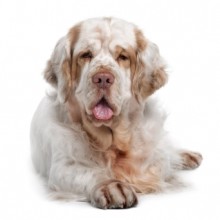Clumber Spaniel
Lifestyle Needs

The Clumber Spaniel is a heavier dog than the Cocker or Springer and has been allowed to become even heavier in the past fifty years with resultant loss of speed and agility. Working Clumbers are lighter and more athletic and could be suitable as a pet provided they are given sufficient exercise. Generally of good temperament. Ideally he will need to live in a house with a garden. His fine coat requires regular grooming to avoid matting and tangles.
Genetic Diversity
(Known as Coefficient of Inbreeding: 'COI'. It should be as low as possible.)
The UK Kennel Club breed average COI is 18.2% - See 'A Beginners Guide to COI'
Gene Pool Size
(Known as Effective Population Size: 'EPS')
24.5
EPS is a measure of how many individuals are contributing genetically to a breed population. It is a measure of the size of the gene pool in a breed. Lower than 100 is considered critical by conservationists and below 50 brings a breed close to extinction. For more information see the Kennel Club article.
Health and Welfare Problems due to Conformation
(Body shape and physical characteristics)
- Excess loose facial skin with conformational defects of the upper and/or lower eyelids so that the eyelid margins are not in normal contact with the eye lower. This can allow dust particles to collect, causing irritation or damage to the eye.
- Excess weight can cause strain on joints and exercise intolerance
- The large, pedulous ear flaps can give rise to ear infections. Ears should be checked on a regular basis.
- The Clumber’s long, low structure may predispose the breed to intervertebral disc disease, causing serious back pain
BVA/KC Health Schemes: www.bva.co.uk/chs
- Hip dysplasia: breed 5 year mean score 15.5 (parents should be much lower)
- Elbow dysplasia: ideally O:O
- Eye Scheme
Identified by the UK Kennel Club as part of their Breed Health and Conservation Plan
Estimated Breeding Values (EBVs) : EBVs for Hip Dysplasia are available for this breed
www.thekennelclub.org.uk/about-ebvs
DNA Tests Available
DogWellNet and IPFD Harmonisation of Genetic Testing for Dogs (HGTD)
www.dogwellnet.com/breeds
- Pyruvate Dehydrogenase Phosphatase 1 Deficiency (PDP1)
- Exercise induced collapse (EIC)
Availability of a DNA test does not mean that it is always necessary or even desirable for breeders to use this test.
Other Breed-Specific Health Screening Schemes
None known
Ask the breeder to show you the certificates for the above tests/screening for both parents. If any of the above tests have not been considered necessary by the breeder (and there may be good reasons), ask her to explain why.
Other Diseases Reported
(For which there are currently no genetic or screening tests for sire or dam)
- Diamond eye
- Entropion
- Ectropion
- Dystocia
- Ear infections
- Anal gland impaction
- Elbow breaks
- Pyruvate Dehydrogenase Phosphatase Deficiency (PDP1)
Ask the breeder about the medical history of the parents, grandparents and great grandparents. Consider carefully whether to purchase a puppy if some of these or other diseases are in the family line.
Ask about the breeder’s policy in cases of serious genetic diseases occurring to your puppy in later life. Good breeders will request to be informed of such events in order to improve future breeding decisions.
You are strongly advised to buy from a breeder who uses (or is prepared to use) the AWF Puppy Contract and Puppy Information Pack (PIP): www.puppycontract.org.uk
The breeder should also be familiar with the CFSG/DBRG Code of Practice for Dog Breeding
Or the Kennel Club’s Assured Breeders Scheme Standard and Guidance:
Standard PDF | Guidance PDF